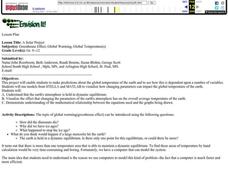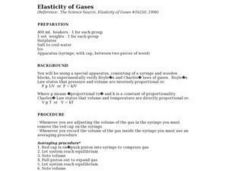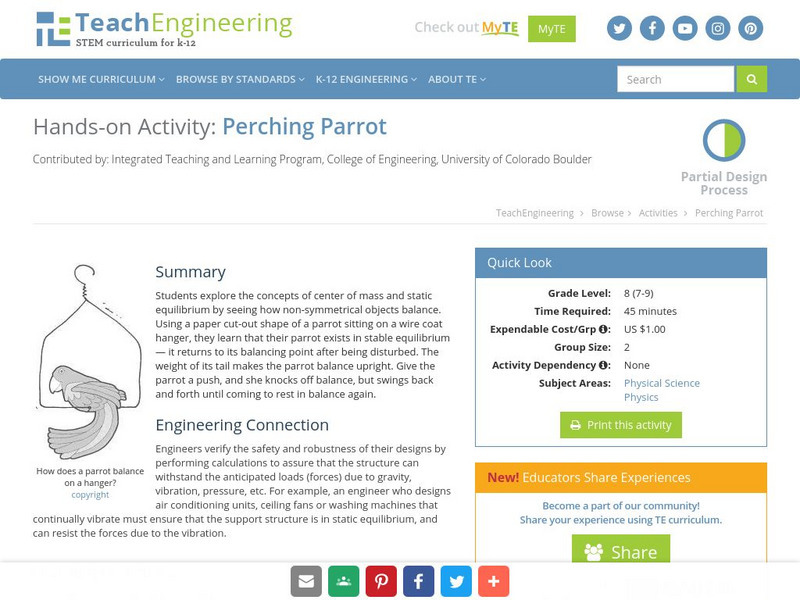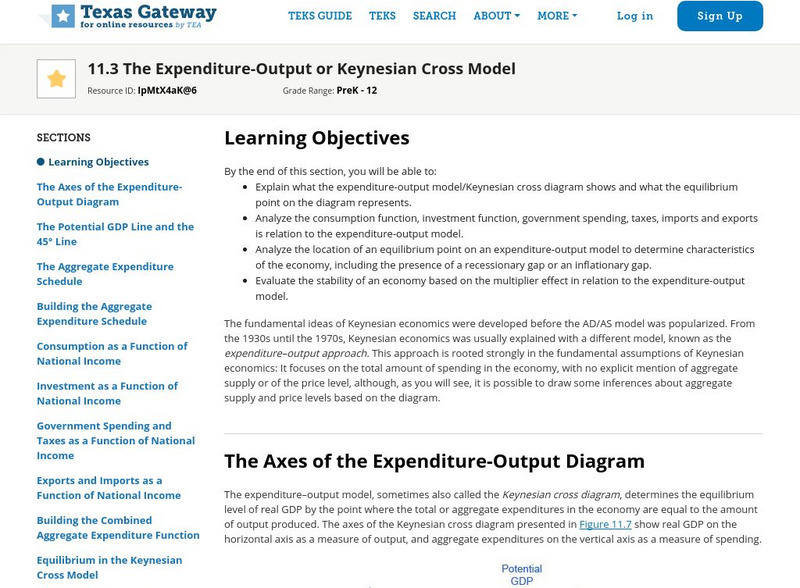Curated OER
Setting Up Equations
In this setting up equations worksheet, learners solve 4 different problems that include setting up the equations in each problem. They write out an equation or set up an equations that describe each given situation. Then, students state...
Curated OER
Mr. Yamada’s Tips for Success on Current Events Commentary: Macroeconomics
In this economic systems worksheet, learners read and follow the provided 5 tips to locate, analyze, and discuss macroeconomics current event issues.
Curated OER
Simple Harmonic Motion
Students explain the theory of simple harmonic motion (SHM) by performing hands-on, practical application experiments.
Curated OER
A Solar Project
Students make predictions about the global temperature of the earth and to see how this is dependent upon a number of variables. Students visualize how changing parameters can impact the global temperature of the earth.
Curated OER
The Economics of Valentine's Day
Young scholars develop an understanding of the determinants of supply and demand. They use this understanding to explain changes in how supply and demand affect the price and the quantity exchanged of roses.
Curated OER
Elasticity of Gases
Students investigate gas laws and apply them in experimental conditions. Using an apparatus composed of a syringe and wooden blocks, they experimentally verify Boyle's and Charles' laws of gases.
Curated OER
Balance and Gravity
Students examine the concepts of balance. In this balance and gravity lesson students view a demonstration of a leaning tower and see how to find the center of gravity.
Curated OER
Trade Happens Between People
Students work together in groups to participate in a trading game. They are allowed to trade with different people in each round. They discover free and restricted trade.
Curated OER
TE Activity: Build Your Own Mobile
Students inquire into how the center of mass is the key factor in designing cars. They construct an oddly shaped object and determine its center of mass. They find that engineers are able to predict how objects will behave while they are...
Chiral Publishing
Chiral Publishing: An Introduction to Chemistry: Liquids Condensation, Evaporation, Dynamic Equilibrium [Pdf]
This online textbook chapter discusses dynamic equilibrium between liquids and gases, boiling liquids, and particle attractions. Many pictures help to explain the concepts. Also find a detailed chapter review at the end to check for...
Texas Education Agency
Texas Gateway: Ch. 10: Buildling a Model of Aggregate Demand & Aggregate Supply
By the end of this section, you will be able to do the following: Explain the aggregate supply curve and how it relates to real GDP and potential GDP, Explain the aggregate demand curve and how it is influenced by price levels, Interpret...
TeachEngineering
Teach Engineering: Perching Parrot
Students explore the concepts of center of mass and static equilibrium by seeing how non-symmetrical objects balance. Using a paper cut-out shape of a parrot sitting on a wire coat hanger, they learn that their parrot exists in stable...
TeachEngineering
Teach Engineering: How Cold Can You Go?
Students explore materials engineering by modifying the material properties of water. Specifically, they use salt to lower the freezing point of water and test it by making ice cream. Using either a simple thermometer or a mechatronic...
CK-12 Foundation
Ck 12: Earth Science: Agriculture and Human Population Growth Study Guide
[Free Registration/Login may be required to access all resource tools.] Summarizes the key points about the evolution of agriculture and how it has impacted human population growth. Includes a few questions to check for understanding.
Texas Education Agency
Texas Gateway: Chapter 11: The Expenditure Output or Keynesian Cross Model
By the end of this section, you will be able to: Explain what the expenditure-output model/Keynesian cross diagram shows and what the equilibrium point on the diagram represents. Analyze the consumption function, investment function,...
Texas Education Agency
Texas Gateway: Temperature, Kinetic Theory, and the Gas Laws: Phase Changes
By the end of this section, you will be able to interpret a phase diagram; state Dalton's law; identify and describe the triple point of a gas from its phase diagram; and describe the state of equilibrium between a liquid and a gas, a...
University of Notre Dame
Und: Properties of a Pure Substance [Pdf]
Often we find that different phases of pure substances can exist in equilibrium with one another. Let us consider an important gedankenexperiment (Latin-German for "thought experiment") in which we boil water. Ordinary water boiling is...
Science and Mathematics Initiative for Learning Enhancement (SMILE)
Smile: The Center of Mass
This site from the Illinois Institute of Technology provides a lab activity in which students determine the location of the center of mass of an irregularly shaped object. Observations are related to the balancing point of the object....
University of Guelph
University of Guelph: Physics Tutorials: What Is Torque?
This site provides an introductory look at torque, the measure of how much a force acting on an object causes that object to rotate. Provides a definition of torque, illustrations, and also a formula to define torque.
Curated OER
Etc: The Center of Population in the United States, 1790 1900
A map from 1904 of the eastern United States showing the westward progression of the centers of population from 1790 to 1900. "The centre of population is defined as 'the point at which equilibrium would be reached were the country taken...









![Chiral Publishing: An Introduction to Chemistry: Liquids Condensation, Evaporation, Dynamic Equilibrium [Pdf] eBook Chiral Publishing: An Introduction to Chemistry: Liquids Condensation, Evaporation, Dynamic Equilibrium [Pdf] eBook](https://d15y2dacu3jp90.cloudfront.net/images/attachment_defaults/resource/large/FPO-knovation.png)






